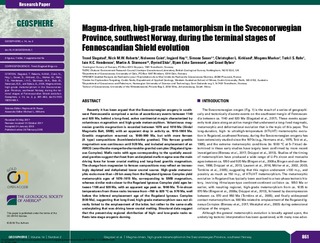| dc.contributor.author | Slagstad, Trond | |
| dc.contributor.author | Roberts, Nick M.W. | |
| dc.contributor.author | Coint, Nolwenn. | |
| dc.contributor.author | Høy, Ingjerd Ulsaker | |
| dc.contributor.author | Sauer, Simone | |
| dc.contributor.author | Kirkland, CL | |
| dc.contributor.author | Marker, Mogens | |
| dc.contributor.author | Røhr, Torkil Sørlie | |
| dc.contributor.author | Henderson, Iain | |
| dc.contributor.author | Stormoen, Martin Austin | |
| dc.contributor.author | Skår, Øyvind | |
| dc.contributor.author | Sørensen, Bjørn Eske | |
| dc.contributor.author | Bybee, Grant M. | |
| dc.date.accessioned | 2019-08-30T09:07:48Z | |
| dc.date.available | 2019-08-30T09:07:48Z | |
| dc.date.created | 2018-05-15T11:39:17Z | |
| dc.date.issued | 2018 | |
| dc.identifier.citation | Geosphere. 2018, 14 (2), 861-882. | nb_NO |
| dc.identifier.issn | 1553-040X | |
| dc.identifier.uri | http://hdl.handle.net/11250/2611791 | |
| dc.description.abstract | Recently it has been argued that the Sveconorwegian orogeny in southwest Fennoscandia comprised a series of accretionary events between 1140 and 920 Ma, behind a long-lived, active continental margin characterized by voluminous magmatism and high-grade metamorphism. Voluminous magnesian granitic magmatism is recorded between 1070 and 1010 Ma (Sirdal Magmatic Belt, SMB), with an apparent drop in activity ca. 1010–1000 Ma. Granitic magmatism resumed ca. 1000–990 Ma, but with more ferroan (A type) compositions (hornblende-biotite granites). This ferroan granitic magmatism was continuous until 920 Ma, and included emplacement of an AMCG (anorthosite-mangerite-charnockite-granite) complex (Rogaland Igneous Complex). Mafic rocks with ages corresponding to the spatially associated granites suggest that heat from underplated mafic magma was the main driving force for lower crustal melting and long-lived granitic magmatism. The change from magnesian to ferroan compositions may reflect an increasingly depleted and dehydrated lower crustal source. High-grade metamorphic rocks more than ∼20 km away from the Rogaland Igneous Complex yield metamorphic ages of 1070–1015 Ma, corresponding to SMB magmatism, whereas similar rocks closer to the Rogaland Igneous Complex yield ages between 1100 and 920 Ma, with an apparent age peak ca. 1000 Ma. Ti-in-zircon temperatures from these rocks increase from ∼760 to 820 °C ca. 970 Ma, well before the inferred emplacement age of the Rogaland Igneous Complex (930 Ma), suggesting that long-lived, high-grade metamorphism was not directly linked to the emplacement of the latter, but rather to the same mafic underplating that was driving lower crustal melting. Structural data suggest that the present-day regional distribution of high- and low-grade rocks reflects late-stage orogenic doming. | nb_NO |
| dc.language.iso | eng | nb_NO |
| dc.publisher | Geological Society of America | nb_NO |
| dc.rights | Navngivelse-Ikkekommersiell 4.0 Internasjonal | * |
| dc.rights.uri | http://creativecommons.org/licenses/by-nc/4.0/deed.no | * |
| dc.title | Magma-driven, high-grade metamorphism in the Sveconorwegian Province, southwest Norway, during the terminal stages of Fennoscandian Shield evolution | nb_NO |
| dc.type | Journal article | nb_NO |
| dc.type | Peer reviewed | nb_NO |
| dc.description.version | publishedVersion | nb_NO |
| dc.source.pagenumber | 861-882 | nb_NO |
| dc.source.volume | 14 | nb_NO |
| dc.source.journal | Geosphere | nb_NO |
| dc.source.issue | 2 | nb_NO |
| dc.identifier.doi | 10.1130/GES01565.1 | |
| dc.identifier.cristin | 1585086 | |
| dc.description.localcode | © The Authors Gold Open Access: This paper is published under the terms of the CC-BY-NC license. | nb_NO |
| cristin.unitcode | 194,64,90,0 | |
| cristin.unitname | Institutt for geovitenskap og petroleum | |
| cristin.ispublished | true | |
| cristin.fulltext | original | |
| cristin.qualitycode | 1 | |

